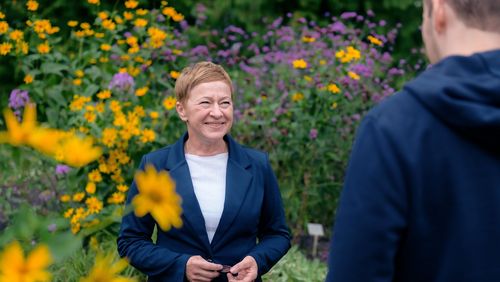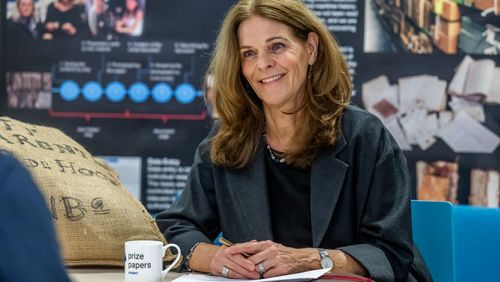Museum researcher Christopher Sommer studies how museums represent wars and how this is perceived by visitors. His research reveals that there is often a large gap between the desired effect and the actual impact on the public.
The aeroplane hovering above the ground looks large and menacing. The bomb-bay doors are open with several bombs dropping out of it. Those who visit the Bundeswehr Military History Museum in Berlin-Gatow and see this scene are supposed to grasp that a process of major destruction is being simulated here. The model on display is a Heinkel 111, a bomber used by the German Wehrmacht during the Second World War. German soldiers used these aircraft to inflict devastating damage and suffering on other countries in operations such as the bombing of Rotterdam in 1940. Right next to the aeroplane model is a fragment of a frieze from an orphanage in the Dutch city which was badly damaged during the bombing. The curators’ message is that as fascinating as war technology may be, it mainly brings about destruction and death. But does this message get through to the public?
In his project “Taming War – The representation and perception of war in military history museums”, funded by the German Research Foundation, historian and museum researcher Dr Christopher Sommer is looking at how museums represent wars and what effects these representations have on visitors. “I want to show what views of history are behind such exhibitions and how these are perceived in different memory landscapes. Armed with this knowledge, we can gain a better understanding of how certain scenographic strategies affect visitors, which can also be useful in the design of future exhibitions,” Sommer explains. The researcher has visited 23 military history museums in Germany, the UK and New Zealand so far, analysed the exhibitions there and conducted interviews with museum visitors in eleven of them. Sommer is particularly interested in the effect of large exhibits such as combat vehicles or aircraft, as well as dioramas – which are model representations of, for example, battle scenes in a recreated setting.
Museums enjoy a high degree of credibility
“The public tends to attribute a high level of credibility and scientific rigour to museums,” Sommer observes. But the question of how a curator conceptualises an exhibition and how visitors interpret that exhibition has a lot to do with political and cultural attitudes and views. Sommer has found, for example, that the two world wars tend to be portrayed in a more “heroic” light in British and New Zealand museums while in Germany a more critical and distanced view of the wars prevails. “This is a result of a critical attitude towards National Socialism and militarism in Germany,” explains Sommer. However, just because a museum pursues a certain curatorial approach doesn’t mean that its visitors will automatically perceive an exhibition in the intended way. Sommer spoke to a visitor to the exhibition in Berlin-Gatow mentioned at the beginning of this article who didn’t even notice the damaged orphanage exhibit. His attention was focused on the technology and “authenticity” of the bomber on display next to it instead. “This example shows that although museums like the one in Berlin-Gatow try to contextualise the effects of weapons, some visitors initially ignore such attempts and are more fascinated by the technology of the weapons,” explains Sommer.
Exhibitions can’t capture “real” war situations
Through the use of dioramas and large exhibits in particular, museums aim to convey a concrete image of the past. “Many museums aim to appeal to their visitors not only on an intellectual level, but also at the emotional level,” says Sommer. The exhibits combine aesthetic qualities – their formal language — with the sense of awe that they often evoke. “This combination of ‘thrill’ and aesthetics can prompt museum visitors to marvel rather than reflect,” says Sommer. On the other hand, he notes, the combination of exhibits, videos, texts and photographs used in such exhibitions offers an immersive experience that appeals to different senses and can also stimulate reflection through the emotions they evoke. However, museums should always convey to their guests that even the best-curated exhibition can never truly represent a “real” war situation, but is merely a simulation. Otherwise, there is the danger that the traumatic experiences that war entails for many people will be underestimated. Exhibitions should also work with multiple perspectives, in other words, with sources from actors from the different parties to a war, and encourage their visitors to think critically.
Based on his interviews with visitors to military history exhibitions, Sommer has established that biographies and individual fates have the biggest emotional impact. Visitors are particularly moved by depictions of wounded soldiers or grieving protagonists. Representations of death are rare and mostly take the form of placeholders – for instance a helmet with a bullet hole. There are also audio-visual exhibits that approach the themes of “wounds” and “death” in a sterile, medical manner. An interactive station in New Zealand's National Museum shows the effects of various weapons on the human body – but in a stylised form reminiscent of X-ray images. German museums are more reserved in this respect and continue to favour photographs or exhibits. In both German- and English-speaking countries, many visitors attach great importance to visualising the effect of weapons on the human body: in their minds, death and injury are inextricably tied up with war, and must be represented – albeit in a gentler form.
Gender and ethnicity play an increasingly important role – an example from New Zealand
Sommer also deals with questions of gender and ethnicity. For example, there is a trend towards women featuring more frequently in exhibitions about war – and this is taking up an increasing amount of space in military museums. Some of the images are very clichéd: women are often portrayed in gendered emotional states, in a medical role, or as civilians, and frequently as victims of sexualised violence. In an exhibition at the Museum of New Zealand Te Papa Tongarewa dealing with the First World War, for example, the only figure that is crying is a nurse. Sommer also sees evidence of the persistence of ethnic stereotypes informed by colonialism. That same museum, for example, shows a larger-than-life figure of a Māori soldier from the New Zealand army defending a position during the Battle of Gallipoli in the First World War. His stoic facial expressions, an audio excerpt from his diary in which he gives a matter-of-fact account of the dramatic scene, set to music that includes the “Ka Mate”, a Māori hake widely known from sport event contexts, all serve to suggest “stoic masculinity” and the will to fight. In this way, the exhibition, whose curators had actually aimed to emphasise the contribution of the Māori to the Gallipoli campaign, unintentionally reproduce the colonial-era idea of “martial races” – members of indigenous peoples who were supposedly “born to fight”. In conversations with Sommer, visitors unanimously praised the museum for including the nurse and the Māori soldier in the exhibition. Sommer sees this an indication of an unquestioning attitude towards gender roles, as well as a lack of reflection on identifying characteristics that go beyond physical fields of activity for Māori, who even today are still expected to perform physical rather than mental labour. The researcher attributes the latter to a lack of knowledge about the colonial era and the New Zealand Wars in particular.
Military history museums are now increasingly using digital technologies to immerse their visitors in virtual historical scenarios via headset or smartphone. Extended Reality (XR) technology is also used to give visitors the opportunity to take part in the action themselves. In a follow-up project (see box), Christopher Sommer plans to investigate how this new form of communication affects the perception of war history exhibitions and public views of history.






